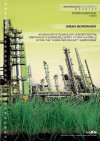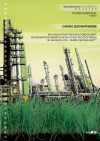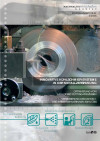Suchergebnisse
Green Biorefinery

An innovative Technology Concept for the Creation of a Sustainable Supply of Raw Materials within the "Fabrik der Zukunft" Subprogram
Forschungsforum
1/2004
Herausgeber: BMVIT
Englisch, 6 Seiten
Downloads zur Publikation
Grüne Bioraffinerie

Ein innovatives Technologiekonzept zur Schaffung einer nachhaltigen Rohstoffbasis im Rahmen von "Fabrik der Zukunft"
Forschungsforum
1/2004
Herausgeber: BMVIT
Deutsch, 6 Seiten
Downloads zur Publikation
ZERIA 3 (Zero Emissions Research in Application)
Erarbeitung von Methoden zur Umsetzung eines abfall- und emissionsfreien Produzierens. Die Ergebnisse zeigen, dass die Zero Emissions-Option eine reale ist und in vielen Fällen wirtschaftlich erreicht werden kann.
ZERIA 3 (Zero Emissions Research in Application)
Elaboration of the principles for zero emission enterprises. The results show that this approach can be realistic and economically advantageous in many cases.
RAINBOW 2
Überführung der in Rainbow 1 erarbeiteten Kenntnisse zur Entwicklung funktionalisierter Fasern aus nachwachsenden Rohstoffen in einen halbtechnischen Maßstab sowie auf verschiedene Faserherstellungsverfahren.
RAINBOW 2
Application and expansion of knowledge gained in the project Rainbow1 for the production of new, functionalised fibres using renewable resources as well as other fibre manufacturing methods in a pilot plant scale production.
Grüne Bioraffinerie - Verwertung der Grasfaserfraktion
Grundsätzliche Versuche zur Klassifizierung und Verwertung von abgepressten Gras. Die Verwendung der Grasfaserfraktion zur Herstellung von Produkten für die Anwendungsbereiche Dämmmaterial, Pflanzmedium und Tierfuttermittel wird exemplarisch untersucht.
Grüne Bioraffinerie - Gewinnung von Proteinen aus Grassäften
Erforschung und Entwicklung eines technischen Verfahrens zur Proteingewinnung aus Gras, in Hinsicht auf Hochprotein-Futtermittel mittels Ultrafiltration und diversen Aufschlußverfahren.
ZERMET - Zero Emission Retrofitting For Existing Textile Plants
Minimisation of the consumption of water, chemicals and energy in the textile industry. Further development of the ZERMEG approach in the form of a questionnaire and application in the textile industry.
Chemistry, process design and sustainable economic development
The results of this project were to deliver the basics for chemical process engineering taking into account the requirements of sustainable development. The proposed results will have to be in conformity with ecological, economic and social requirements for sustainability. Hence the processes will mostly be based on renewable resources.
ZERMET - Zero Emission Retrofitting For Existing Textile Plants
Minimierung des Einsatzes von Wasser, Chemikalien und Energie in der Textilindustrie. Weiterentwicklung des Ansatzes von ZERMEG in Form eines Fragenkatalogs und die Anwendung auf die Textilindustrie.
Elaboration of the conditions to build up a reuse-cycle network for WEEE
Selection of electrical and electronic equipment disposed as waste back into a reuse-cycle, bulding up an operational network between social enterprises, linking up and improving the workflows necessary for this purpose and the creation of a second-hand-shop for electrical an electronic equipment.
Green Biorefinery - Separation of Proteins from Grass Juice (Green Juice)
Research and development of the technical process to separate protein from grass juice to gain high-protein concentrate for animal feed by ultra-filtration and other separation technologies.
Umsetzungsorientiertes Konzept zur Implementierung industrieller Nachhaltigkeitsnetzwerke
Ausgehend von herkömmlichen und recyclingorientierten Wertschöpfungsketten bzw. netzen wird ein Konzept zur Implementierung von industriellen Nachhaltigkeitsnetzwerken entwickelt. Gemeinsam mit einer zu gründenden Taskforce wird eine Pilotumsetzung vorbereitet.
INNANET - Practice-oriented concept for implementation of industrial sustainability-networks
On the basis of conventional and recycling-oriented supply-chains and/or -networks a concept for the implementation of industrial sustainability networks will be developed. Together with a taskforce which needs to be founded a pilot implementation will be prepared.
Innovative Kühlschmier-Systeme in der Metallzerspanung

Optimierung von High speed Cutting-prozessen, Verbesserung des Umwelt- und ArbeitnehmerInnen-Schutzes.
Forschungsforum
3/2006
Herausgeber: BMVIT
Deutsch, 6 Seiten
Downloads zur Publikation
Green Biorefinery - Separation of Lactic Acid from Grass Silage Juice (Brown Juice)
Development of a technical process to separate lactic acid from Brown Juice. Lactic acid is a promising chemical commodity which may be produced from silage juice at low costs and in an environmentally friendly way for subsequent synthesis of valuable products.
Grüne Bioraffinerie - Gewinnung von Milchsäure aus Grassilagesaft
Erforschung eines technischen Verfahrens zur Milchsäuregewinnung aus Grassilagen. Milchsäure, eine vielversprechende ökologische Basischemikalie, wird aus fermentierter Grünmasse kostengünstig gewonnen, um zu hochwertigen Produkten weiterverarbeitet werden zu können.
Analysis of the sealing water costs in the paper- and pulp industry
From all information should be made a tool for soul-searching, which allows all operators of pumps to calculate the possible reduction of costs (energy, cost of operaton, amount of fresh water, ...).
Analyse der Sperrwasserkosten in der Papier- und Zellstoffindustrie
Aus den erhobenen Daten soll ein Werkzeug zur Selbstanalyse für die Betreiber von Stoffpumpen entwickelt werden, welches das Einsparungspotential (Energie, Betriebskostosten, Frischwassermenge, ... ) ermittelt.
